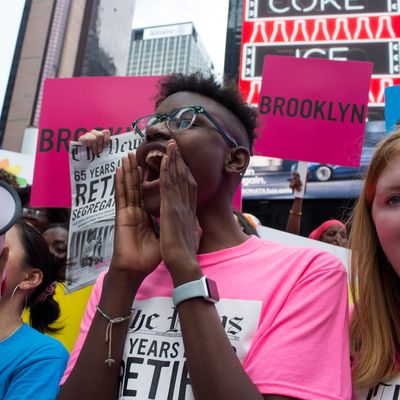
The 70th anniversary of the Supreme Court’s Brown v. Board of Education decision, which outlawed racial segregation in public schools, came and went in New York with little official notice. Perhaps our leaders were embarrassed by the fact that our city has been cited for more than a decade as having the nation’s most racially segregated schools and has done little or nothing to implement dozens of reasonable proposals to move in the direction of integration.
“We have the outline, we have the blueprint. Integration is feasible. It’s within our reach,” says Nyah Berg, the executive director of New York Appleseed, a nonprofit organization that advocates for integrated schools around the state. I recently sat down with Berg and Matt Gonzales, who works at the Metropolitan Center for Research on Equity and the Transformation of Schools, a division of NYU’s graduate school of education. They are part of a growing movement of young researchers and advocates who are fed up with New York’s delays and dissembling on diversity.
“You can’t fix segregation by creating more segregated Stuyvesants, more segregated gifted-and-talented programs. Ultimately, what we’ve always advocated for is that all students in New York City deserve high-quality, diverse, and equitable schools,” Gonzales told me. “There are many policies sitting on the table, literally collecting dust, that can be implemented to decrease segregation in New York City schools.”
It’s easy to miss the segregation that stains and divides our cosmopolitan city. Yes, we all hear the glorious cacophony of the multiple languages spoken in the streets and subways, but New York has long tolerated, instituted, and defended practices — from forcing 4-year-olds to take standardized tests to requiring face-to-face screening interviews as a condition of admission to desirable schools — that inexorably sort students into racial enclaves.
The separation is blatantly visible on maps published at integratenyc. The 40 schools in Manhattan’s District 3, for instance, have a total enrollment of just over 14,000 students, of which roughly 27 percent are white, 24 percent Black, 35 percent Latino, and 8 percent Asian. This is a zone that includes the West Side and part of Central Harlem, running from 59th Street to 122nd Street. But nearly a dozen of the schools are mostly white and Asian, with only a smattering of Black students, while at least 13 schools are more than 90 percent Black and Latino.
“Essentially all students of color attend predominantly nonwhite schools, whereas two-thirds of white students do the same,” a study of New York schools by the UCLA Civil Rights Project found in 2021. “Roughly 85 percent of Black students, and three-fourths of Latino students, attend intensely segregated schools, while only 11 percent of white and 43 percent of Asian students do.
There is no excuse for allowing our kids to grow up in mini-monocultures, subtly promoting the lie that “those people” are fundamentally worse or less deserving than their fellow New Yorkers.
“I have worked on these and related issues for a half-century, and I have never seen a school district that was separate and equal,” Gary Orfield of UCLA wrote in the forward to his 2021 report. “When I have been testifying in a civil-rights case, I have asked experts on the other side to tell me where there is one but have never received an answer.”
A School Diversity Advisory Group, assembled by Mayor Bill de Blasio in 2017, published a well-received report on the need for desegregation. But the group’s second plan, which called for changing or ending the use of screening interviews and tests, got a chilly reception. “The second report had about 30 recommendations, and that really was the teeth to these goals. How were we going to really desegregate?” Berg said. “And that was met with silence.”
For decades, under the Bloomberg and de Blasio administrations, City Hall tended to mischaracterize the issue as a scarcity problem, as if segregation were a natural outcome because high-performing schools are like a popular restaurant or hot dance club — a rarefied private space that, by definition, is available only to a fortunate few. That velvet-rope approach was soundly rejected by Teens Take Charge, a grassroots organization of young people that staged a string of walkouts and protests in support of integration shortly before the COVID pandemic struck.
Some of the recommendations did get pushed through, like ending the practice of testing 4-year-olds for admission to gifted-and-talented programs and suspending requirements for face-to-face entrance interviews, thanks to the pandemic. “We actually couldn’t use test scores and absences and other [measures] for a middle-school admissions policy because we were under a global pandemic,” Gonzales told me. “But as soon as the Adams administration came into play, they started reversing many of those policies. Some of the responses we’ve heard from the Adams administration is that they can’t correct generational segregation. And we understand that there’s a lot of work to do, but they’ve actually doubled down on many policies that we’ve known for many years contribute to and increase segregation in New York City schools.”
We may need another round of grass-roots effort to restart New York’s desegregation movement. “There are reams and reams of social-science research that showed that integrated schools are good schools,” Berg told me. “Schools need to be integrated to be good. And that’s because it shows increases in academic achievement. It shows increases in graduation rates for those who attended integrated schools. Better health outcomes. And then most important, it prepares students and young folks to participate and be effective in support of a multiracial democracy.”






























